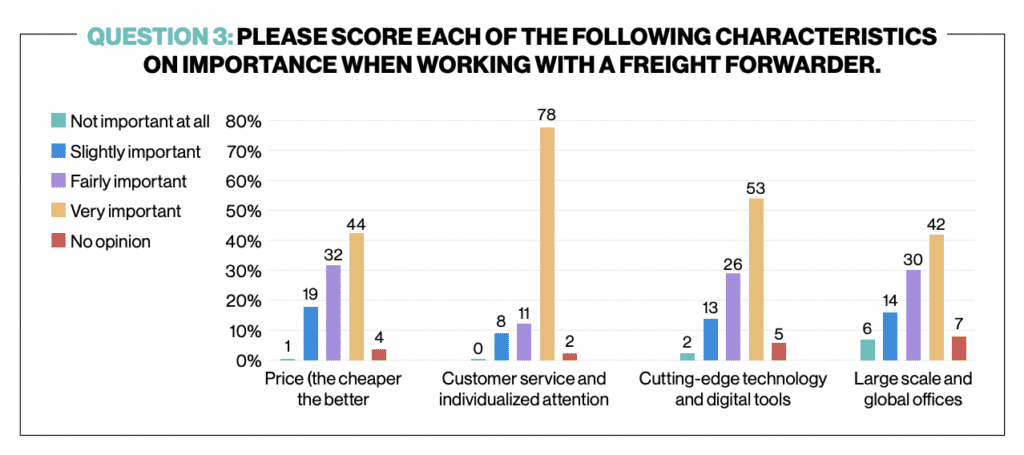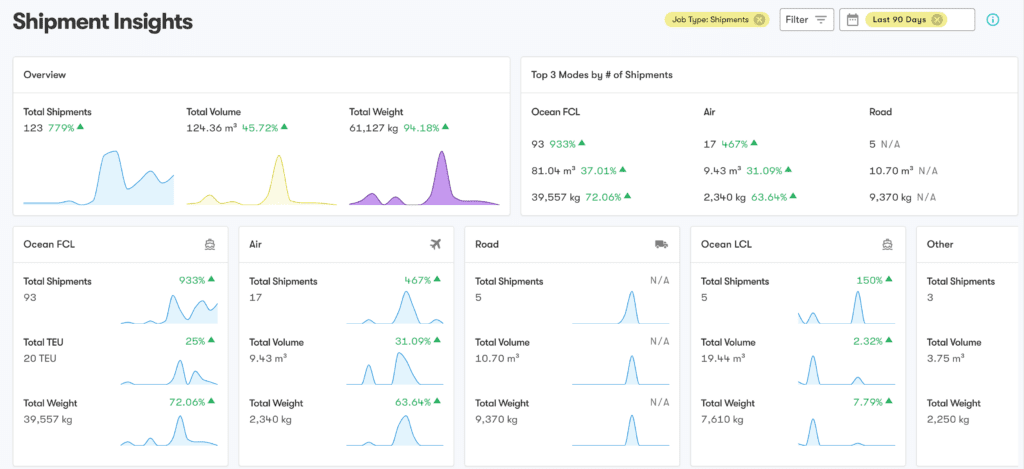As a freight forwarder, setting the right rates for your services can be a challenging task. On the one hand, you want to make a profit and stay competitive in a crowded market. On the other hand, you need to provide value to your clients while also being transparent about the costs involved.
That’s where showing proof comes in. Having solid evidence to back up your rates can make all the difference when it comes to building trust, opening up pricing conversations, and ultimately winning new business. Let’s talk about the issue of proof in freight forwarding, and how you can set and justify your rates in any market.
The state of logistics pricing
Before we dive into the specifics of how to back up your freight rates, let’s take a step back and talk about the issue of pricing in logistics.
Experts find that the sophistication of logistics pricing lags behind other industries. In a report by McKinsey & Company, the consulting firm placed supply chain segments on a pricing maturity level scale. The scale ranged from 1-3, with 1 indicating static pricing and 3 corresponding with best practices.
Most industry segments fell between 1-2, including ocean carriers, air carriers, and freight forwarders. However, e-commerce giants were placed at the top of the scale, with features including “value pricing” and “advanced surcharge structure and value-added services.”
Experts acknowledge that the supply chain landscape makes it difficult to optimize pricing. Because of challenges like industry fragmentation and the complexity of goods, many logistics providers consider themselves price-takers. Instead of setting prices based on factors like value-adds, consumer preferences, and industry conditions, their pricing is simply subject to the whims of the market.
With this model, forwarders may see high profits when margins are high across the industry. However, on the flip side, demand and freight rate drops can lead to low lows for those same providers. By incorporating proof into your pricing model, you can get better and more consistent margins. In fact, McKinsey reports that companies that “transform their pricing could increase revenue by 2 to 4 percent, translating to as much as a 30 to 60 percent increase in operating profit.”
How freight forwarders can benefit from showing proof behind rates
Demonstrating evidence of your forwarding rates can yield more than just enhanced profit margins. It also positions your brand apart from the crowded competition, fosters long-lasting trust, and propels enduring growth. Let’s break down the top three ways that showing proof can improve your business.
Competing with other providers
Due to the saturation of the forwarding industry, many assume that winning a contract is mainly based on price. However, many experts find that this is not the case.
In a recent webinar, FTA’s General Manager of Trade Policy and Operations Sal Milici stated, “If you’re getting just on price alone, then you’re very likely to lose it on price alone, maybe a couple of days after you’ve won it.” Customers seem to back this claim, with a FreightWaves/Logixboard survey finding that price ranks 3rd on a shipper’s list of important characteristics when working with a freight forwarder– behind customer service and technology.

Not only is winning business based on rates ineffective, but it’s also less desirable. Freight rates fluctuate over time, especially in a volatile market, and it’s not always going to pay off to charge just a little bit less than your competitors. On top of that, in markets with zero or negative rates, price-focused customers are going to move away from you. Some may even go straight to the carrier to get rid of the added cost.
Leaning into other areas where you can win often means getting better customers who you can work with to pursue mutual benefits. This will often lead to more productive partnerships that you can grow over time.
Building long-term trust
Coming out of the pandemic-era market, many shippers have become even more skeptical of low rates. Instead of focusing on price, many are looking for a reliable partner who can promise stability. In a Loadstar article, a retailer executive at TPM talked about her frustration with the lack of reliability in shipping. “We have to work together to sort this out,” she said, “it’s absolutely no use getting a silly rate and then finding that they have blanked the sailings or rolled our cargo.”
As shippers aim to find the best logistics partner, many will be looking to forwarders to back up their contract details, including price. When you can demonstrate transparency through proof behind your rates, you build trust with your clients, which can lead to repeat business and referrals.
Opening up pricing conversations in the future
Pricing conversations aren’t only important in ensuring fair rates for your customers– they also prevent you from selling yourself short. When you rely on a static model to set prices, it’s easy to lose track of the value you’re providing.
As you continue to renew contracts with long-standing customers, some forwarders may fall victim to scope creep. That is, when your responsibilities increase without your rates adjusting. This can start to eat into your profit margins by taking up time that you would’ve spent on other tasks, such as contract negotiation or customer acquisition.
By establishing proof in your pricing conversation from the start, you can clarify what you’re providing and what that service is worth. That way, if responsibilities expand in the future, you can adjust your pricing accordingly.
How forwarders can set the right rate in a fluctuating market
With constantly changing market conditions, it’s essential to understand how to determine the right price for your services. Fortunately, with the right approach, you can set a competitive rate that will enable you to provide high-quality services and maintain your bottom line.
Figure out the value of your services
The first step in setting the right rate is collecting and analyzing the data. It’s important to understand market conditions, such as supply and demand, exchange rates, and fuel prices.
Many forwarders use data solutions like Xeneta to benchmark industry rates based on up-to-date insights. From there, they’ll tie their rates to the market, along with a premium for any additional value they’re offering. By starting with a baseline, you can make sure that you’re relying on your services to differentiate you from your competitors– not just price.
If you believe your premium offerings can justify higher rates, figure out how much they’re worth to shippers. You can start by searching available data to identify industry trends. However, in many cases, you’ll want to talk directly to your customers and prospects to figure out how they value your services.
You can get started by using a pricing model, such as the Van Westendorp Price Sensitivity Meter. First, list out which service(s) you want to evaluate, whether it’s expedited shipping, warehousing, customs brokerage, or visibility tech. From there, you can plug each offering into the method’s four questions:
- At what price would you consider the product/service to be priced so low that you feel that the quality can’t be very good?
- At what price would you consider this product/service to be a bargain—a great buy for the money?
- At what price would you say this product/service is starting to get expensive—it’s not out of the question, but you’d have to give some thought to buying it?
- At what price would you consider the product/service to be so expensive that you would not consider buying it?
Craft your sales pitch
Once you’ve developed an initial pricing model, it’s time to figure out how to present your rates to your customers. In this conversation, you’ll highlight the value of your services and explain why your rates are competitive. You may want to emphasize the quality of your services, your experience, and your ability to meet tight deadlines.
Reporting and analytics are going to be essential in demonstrating your value. As you lean into promises like higher accuracy rates and customer satisfaction, your shippers will want to see data to back it up. To accommodate, you can pull out relevant KPIs for every claim to show how you’ve achieved them in the past.
At this stage, using a visibility solution like Logixboard can give your credibility a major boost. By allowing you to access insights from previous shipments, the platform will provide a dynamic, intuitive visual of your previous results. In turn, your shippers will be able to review the data on their own, enabling them to make a decision with confidence.

Periodically evaluate your pricing
Setting the right rate is not a one-time task. Rather, periodically evaluating your pricing strategy is essential to ensure that you remain competitive in the market. You may want to consider conducting a pricing review every quarter or every six months, depending on market conditions. As previously discussed, a benchmarking solution can be a useful tool in creating and maintaining a strategic pricing model.
You can incorporate pricing conversations into your periodic meetings with customers. That way, you’ll have up-to-date information on rates well before contract season.
Final Thoughts
Taking a hold of your pricing in a fluctuating market is a critical task for freight forwarders. By identifying your areas of value, crafting a compelling sales pitch, and periodically evaluating your pricing strategy, you can set competitive rates that provide value to your customers and maintain your bottom line.
Want to learn more about how to hold productive meetings and conversations with your customers? Check out our free QBR presentation template for freight forwarders.
If you’re ready to level up your customer experience, connect with our team to learn how Logixboard’s white-labeled integration can work for your company.
READ MORE FROM THE LOGIXBOARD BLOG
 Matt Fleming
Matt Fleming 



